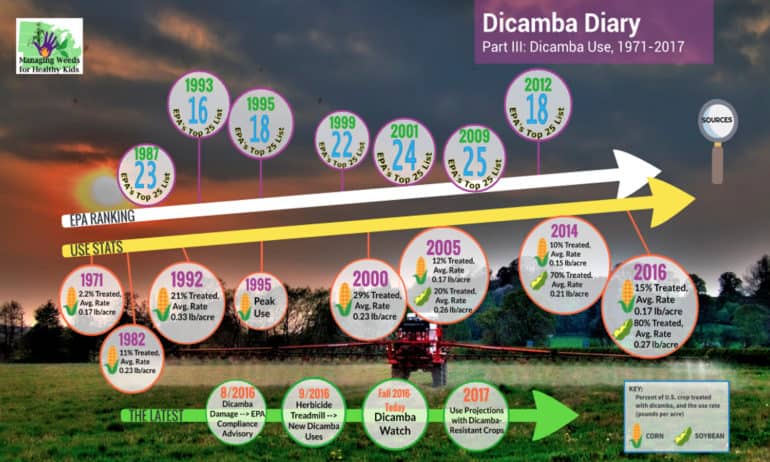 |
| Toolkits to Teach About Pesticides |
This article is a follow-up to our recent post
exploring the political and community conflicts sparked by expanding
use of the pesticide dicamba and describes new research that suggests
that dicamba volatility in United States cropping systems may be more
likely and widespread than has been understood.
A team of researchers from the Children’s Environmental Health Network (CEHN) have produced a set of interactive tools
designed to educate consumers about pesticides that are commonly used
in the Midwest region of the U.S. The tools span a number of online
media platforms and focus on the herbicides that are associated with
genetically engineered (GE) crops grown in the region, including
glyphosate, dicamba, and 2,4-D.
The CEHN researchers note that each of the herbicides they
focus on “has a rich and very long history.” To recount those histories,
they have generated toolkits called The Lowdown on Roundup, The Dicamba
Diaries, and Dicamba Watch, highlighting “key milestones in the
discovery and commercialization, regulation, use, and human health and
environmental impacts” of the pesticides. A toolkit covering 2,4-D is
forthcoming.
Charles Benbrook, former research professor and agricultural
economist with the project, notes that the tools are seeing
significantly increased traffic as herbicides have re-entered the
spotlight in recent months. In July 2017, farmers filed a class action lawsuit against Monsanto, the maker of both dicamba and dicamba-resistant crops, while both Arkansas and Missouri implemented temporary but total statewide bans of the same pesticide in mid-summer.
Glyphosate, dicamba, and 2,4-D have seen widespread use for
decades. The U.S. Environmental Protection Agency (EPA) maintains its
approvals for all three, limited according to usage recommendations that
are printed on the containers in which the pesticides are sold. The
CEHN project researchers, however, question the health implications of
the ways the pesticides are currently applied. Benbrook was quoted in a
recent New York Times article on dicamba warning that, “for both dicamba and 2,4-D, the reproductive risks and birth defects” are “most worrisome.”
The team for the CEHN project, which is called Herbicide Use and Birth Outcomes in the Midwest,
represent institutions and universities from across the continent. Some
of the researchers have been outspoken against the agricultural
biotechnology industry in the past, particularly regarding the
implications of the increasing use of GE crops.









No comments:
Post a Comment